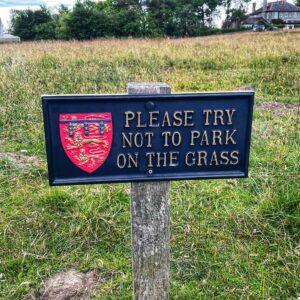A misty start and a downpour overdue from June left little chance for photography this morning. So here is another one from yesterday: the tourist-magnet village of Goathland. Avoiding the coachloads is nearly impossible. The village spreads around a broad common where sheep graze as if unaware they are in a postcard.

A posh sign, complete with the Duchy of Lancaster’s crest, politely requests visitors to “try not to park on the grass.” Many are surprised to learn that not only the commons, but much of the surrounding moorland and farmland, belongs to the Duchy of Lancaster—that is, to the Sovereign.
Goathland is one of five estates that form part of the Duchy’s Yorkshire Survey, a 9,500-acre stretch of countryside, most of it heather moorland and designated a Site of Special Scientific Interest. The other estates are Cloughton, Marishes, Pickering, and Pontefract1From Plough Stots to Pollinators. https://www.duchyoflancaster.co.uk/2024/02/29/from-plough-stots-to-pollinators/.
The story of how the Duchy came to such a great chunk of Yorkshire is lengthy, but the beginning is straightforward. In 1266, Henry III gave his son Edmund the confiscated lands of Simon de Montfort and the Earl of Ferrers. A year later Edmund became Earl of Lancaster, taking ownership of the Pickering-Goathland estates among others.
Over time, more land was added—some by inheritance, some by marriage. By 1351 the fourth earl was made Duke of Lancaster. When he died, his son-in-law John of Gaunt inherited the lot. His son, Henry of Bolingbroke, deposed Richard II and took the throne in 1399. Since then, the Duchy has belonged to the reigning monarch.
The estates have survived sales, mismanagement, and the occasional royal cash crisis. They were flogged off under Cromwell and raided by the Stuarts for funds, but by the 18th century, the Duchy had recovered. It is now a profitable portfolio of land and farms, with occasional purchases and regular updates.
This neat, centuries-old arrangement was given some unwanted attention last year. A Channel 4 documentary, The King, The Prince & Their Secret Millions, and a Sunday Times investigation questioned how the Duchies of Lancaster and Cornwall generate income. The Duchy of Lancaster, for example, had received millions from the NHS for leasing a warehouse used for ambulances. Critics called it inappropriate that the royals should profit—tax-free—from public services2New Documentary Sparks Controversy Over King Charles and Prince William’s Money. VICTORIA MURPHY. .
In the meantime, the sheep in Goathland remain unmoved.
- 1From Plough Stots to Pollinators. https://www.duchyoflancaster.co.uk/2024/02/29/from-plough-stots-to-pollinators/
- 2New Documentary Sparks Controversy Over King Charles and Prince William’s Money. VICTORIA MURPHY.

Leave a Reply